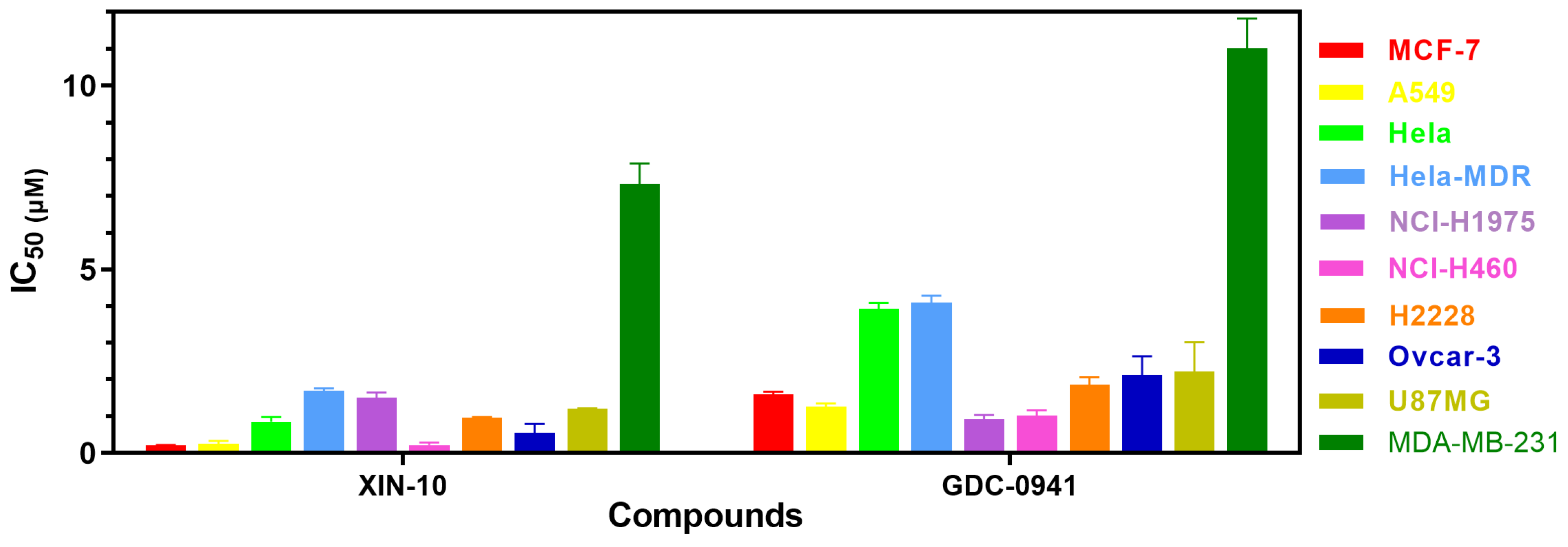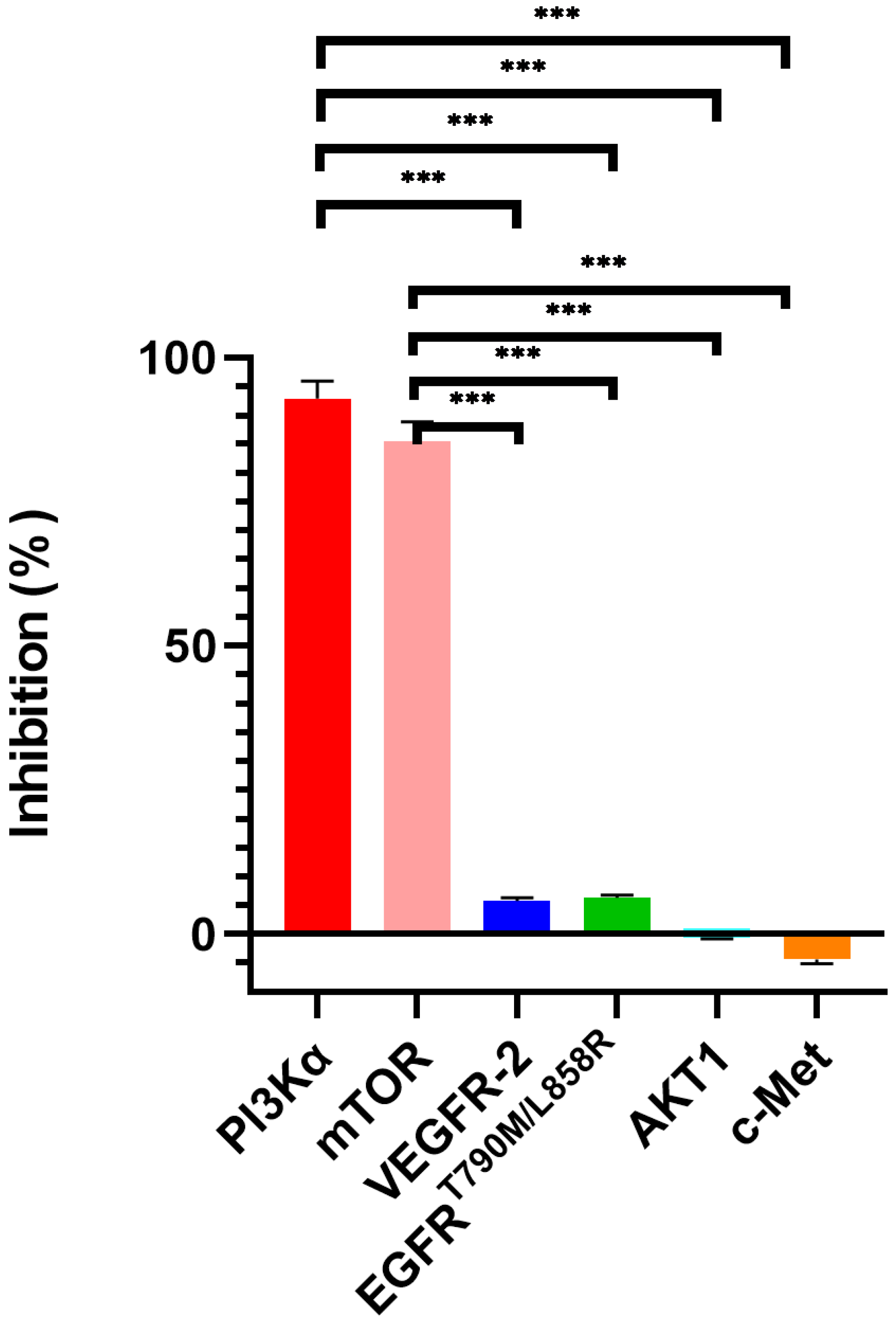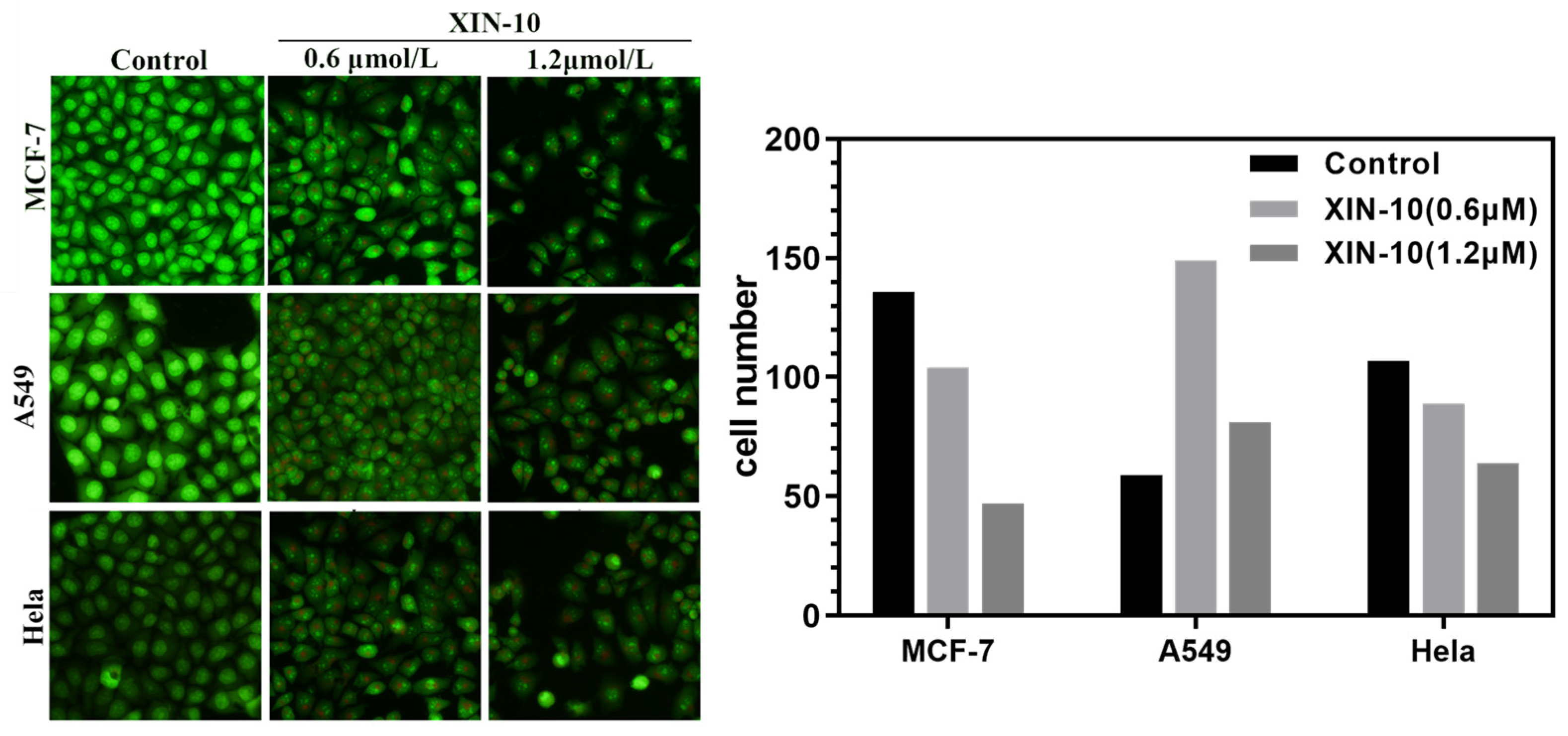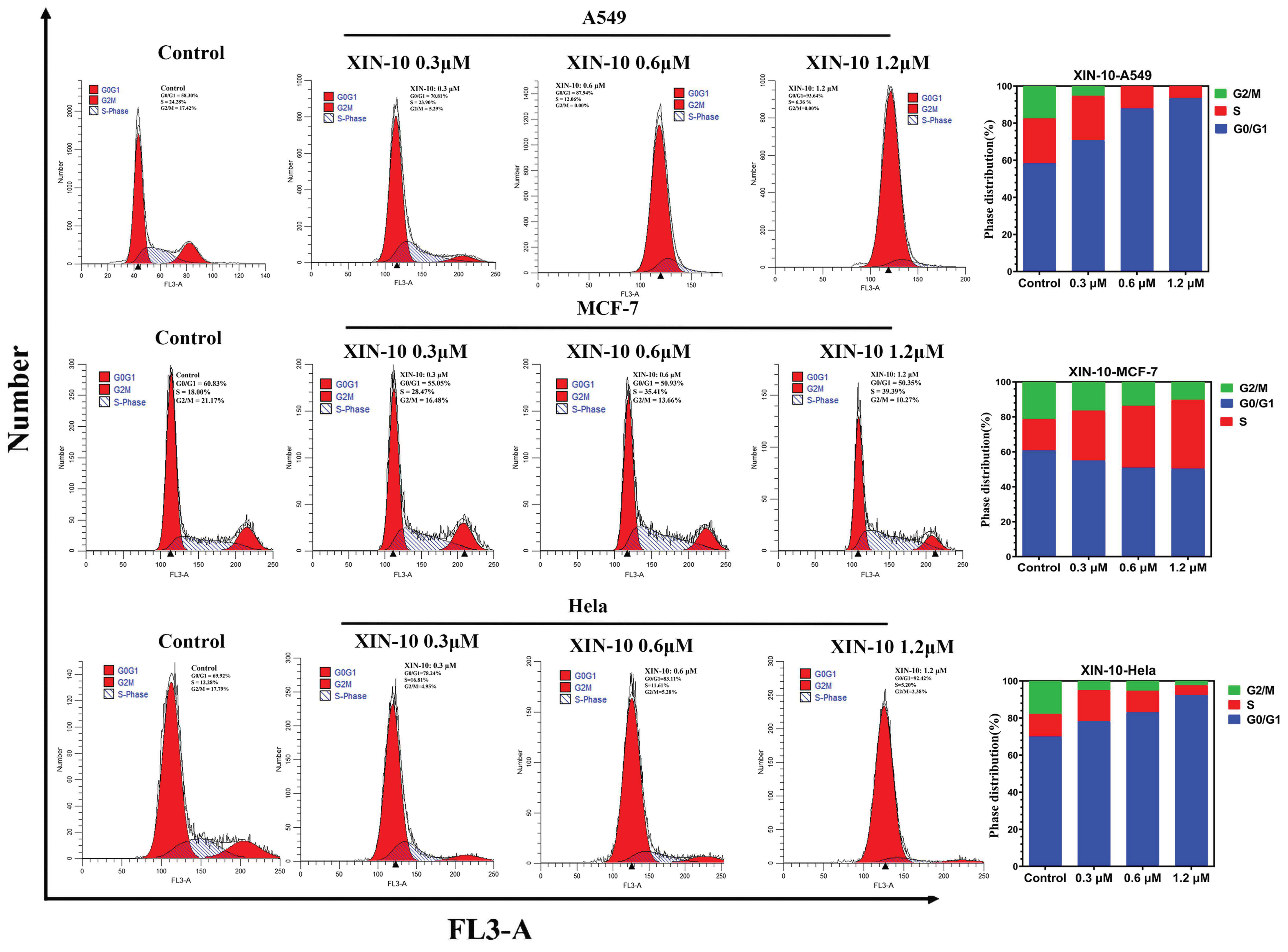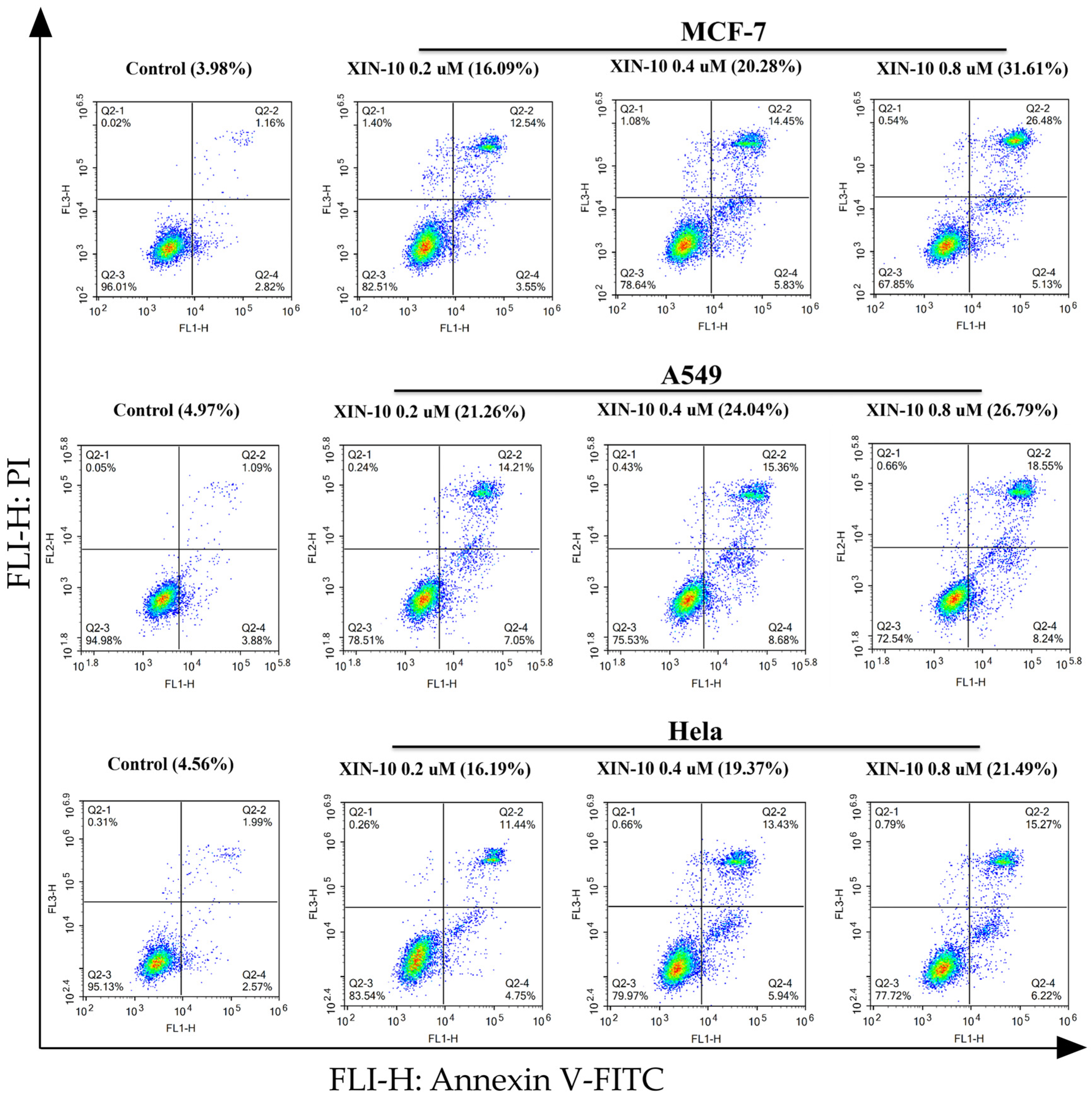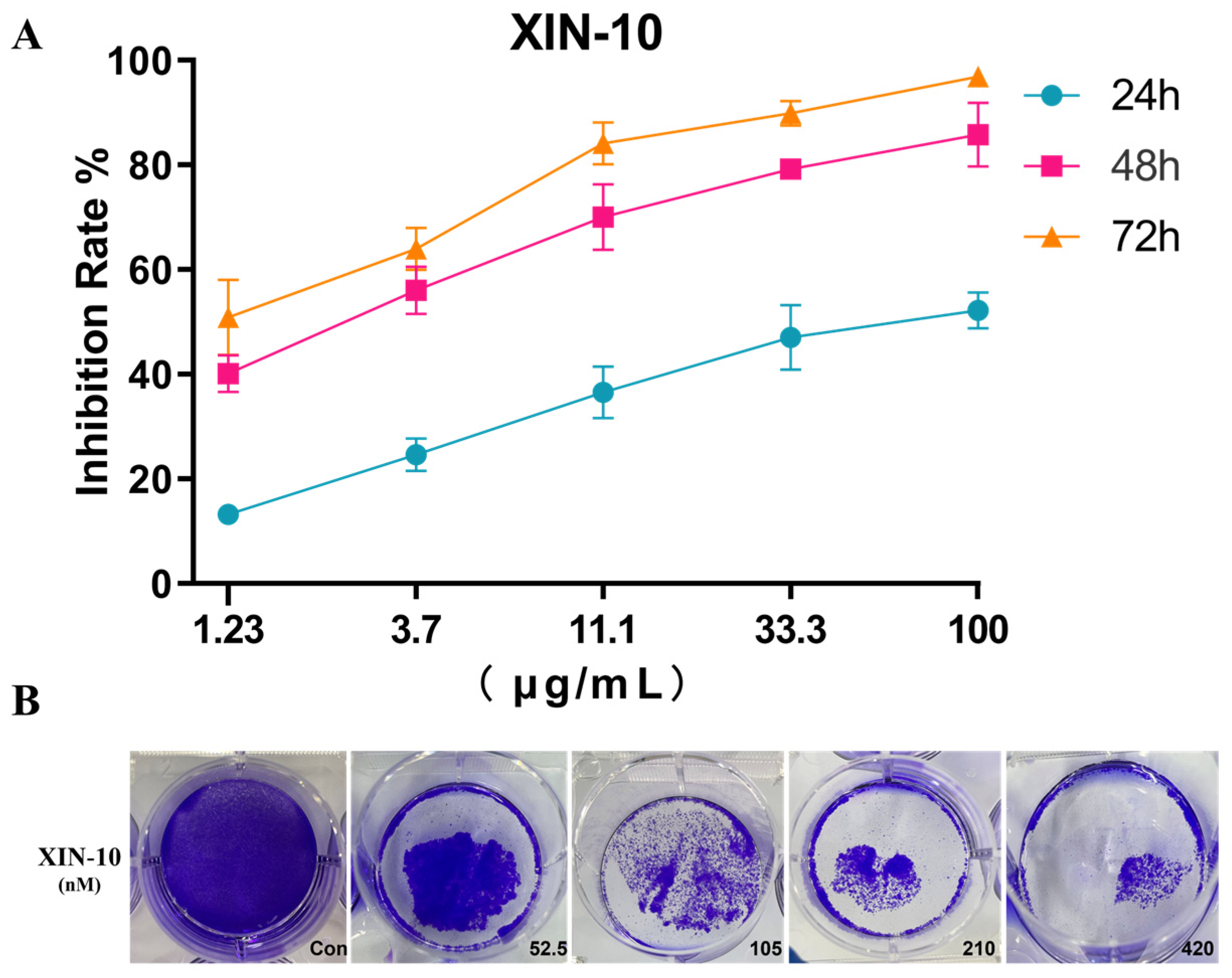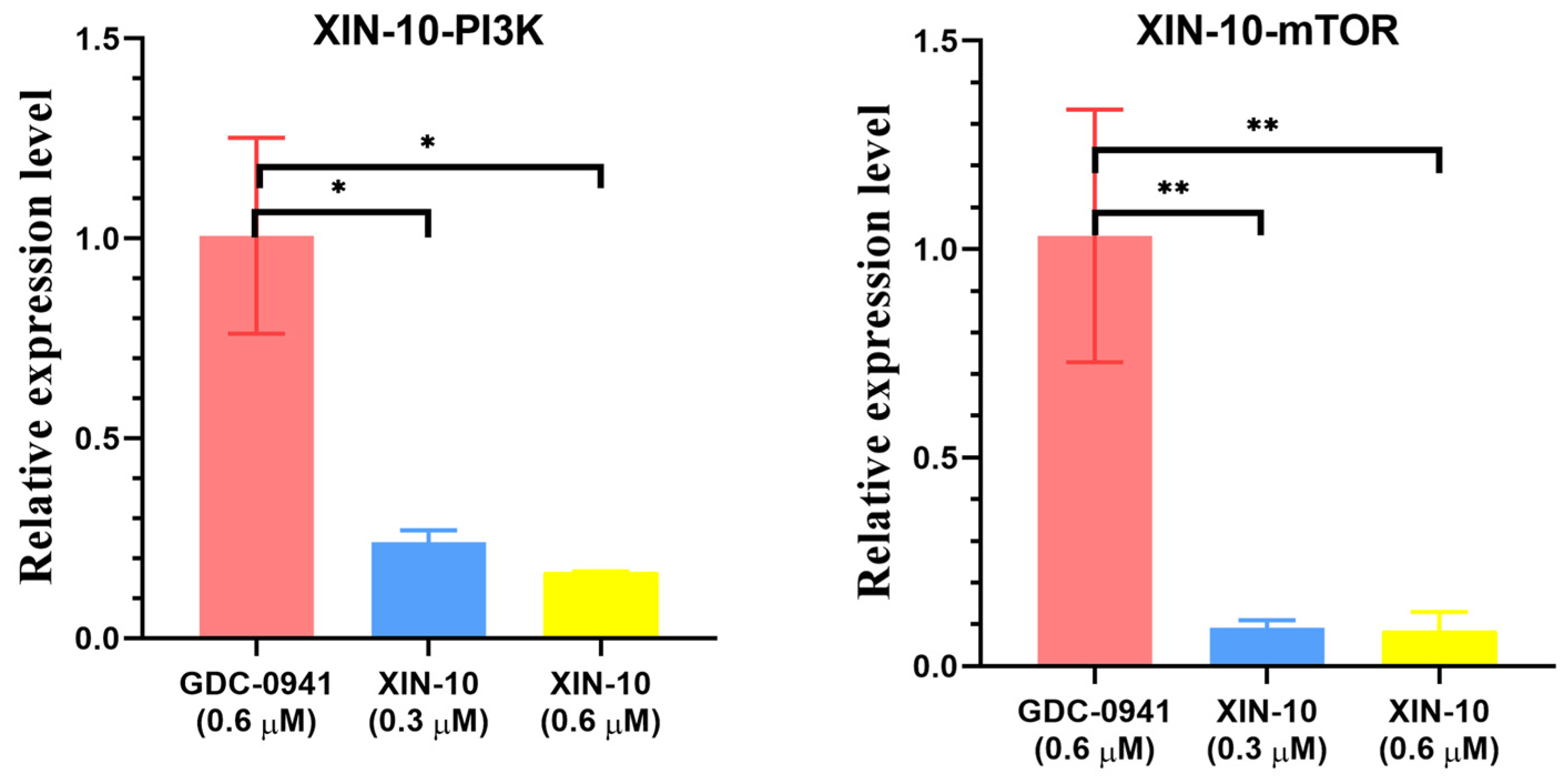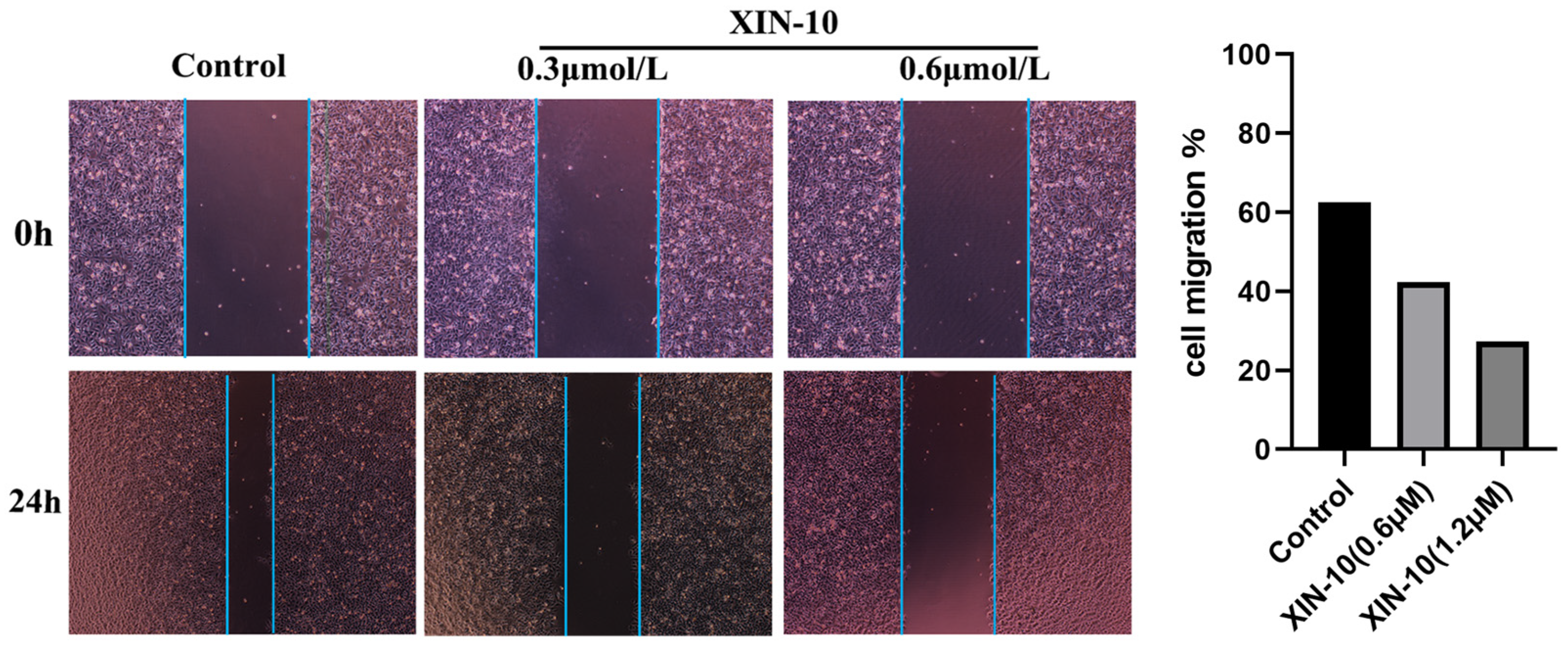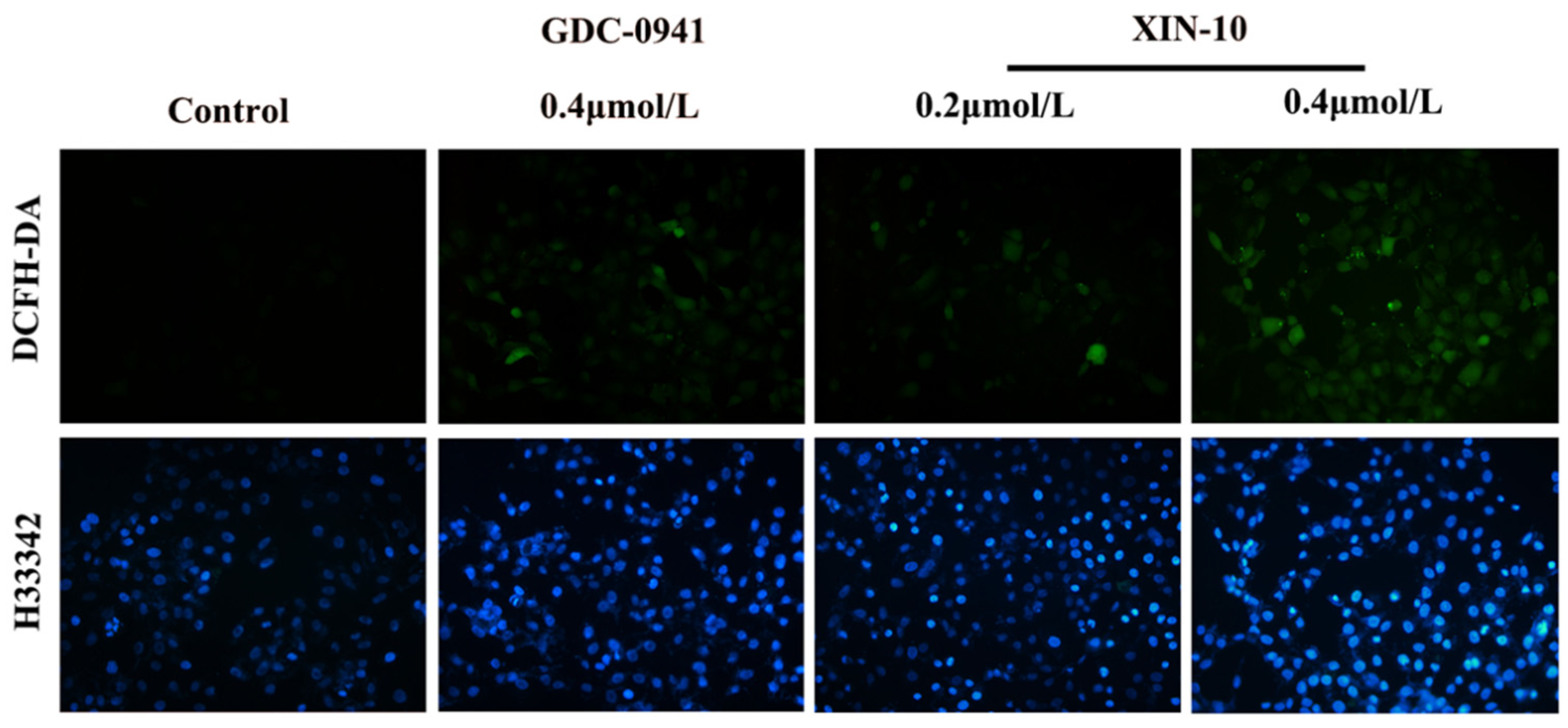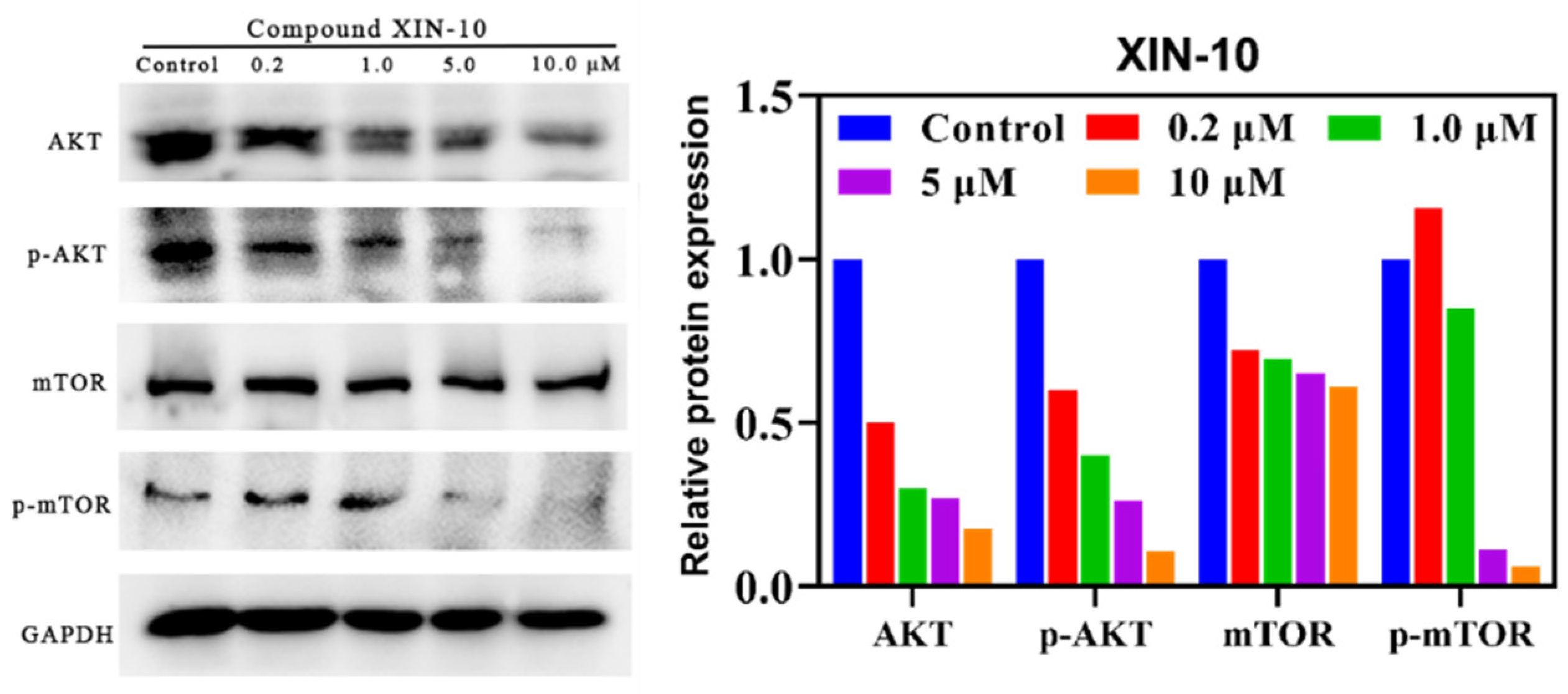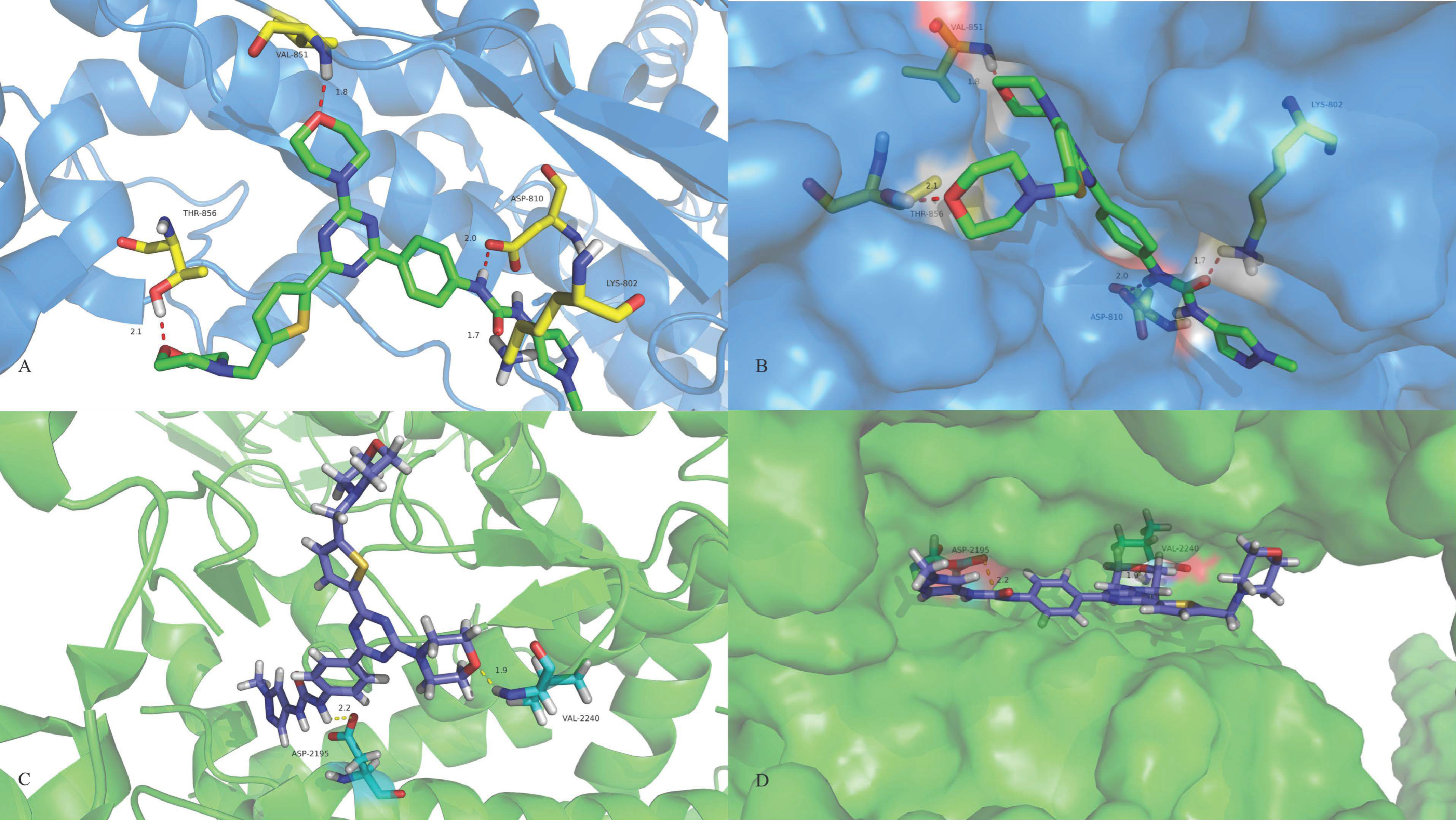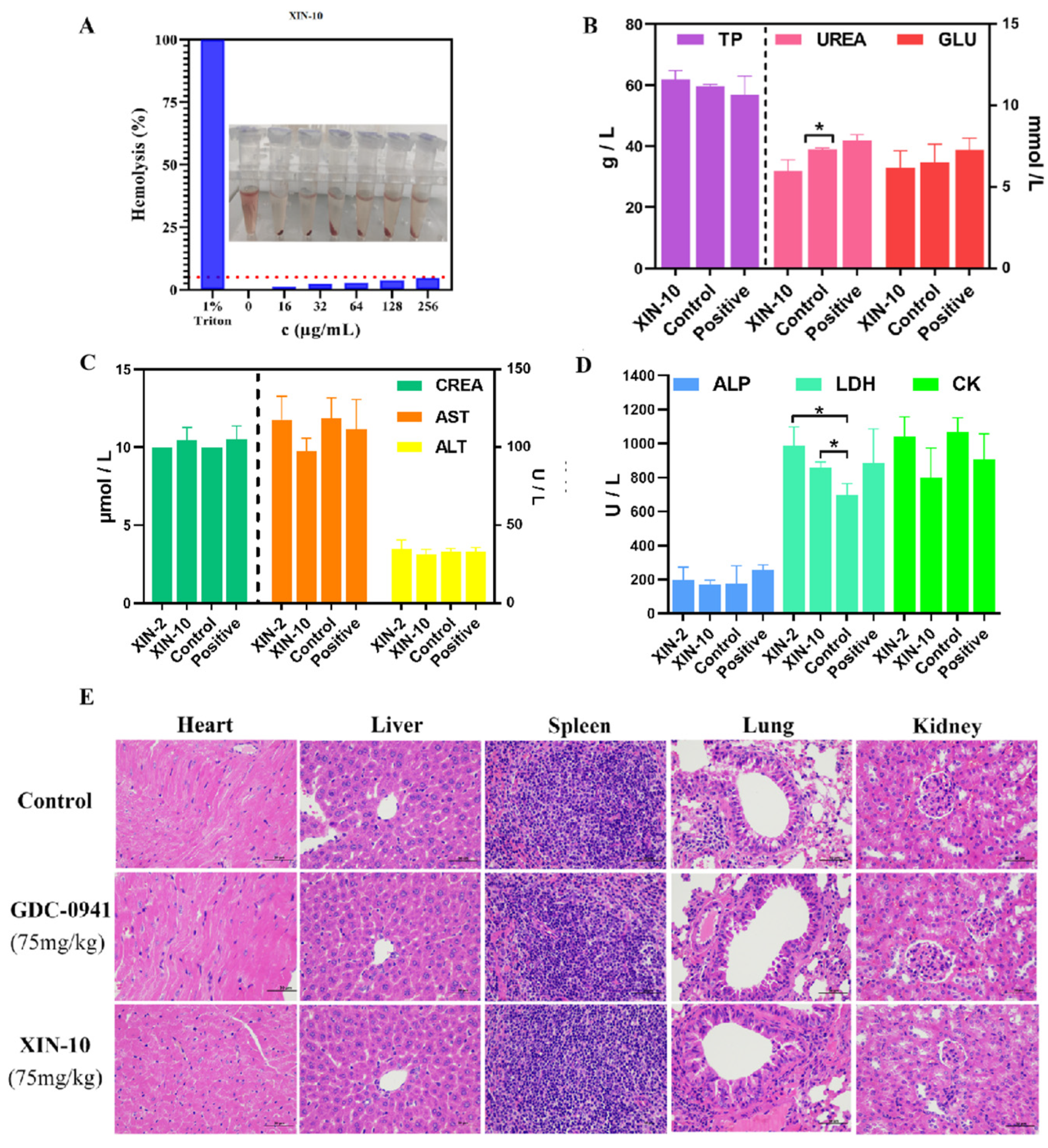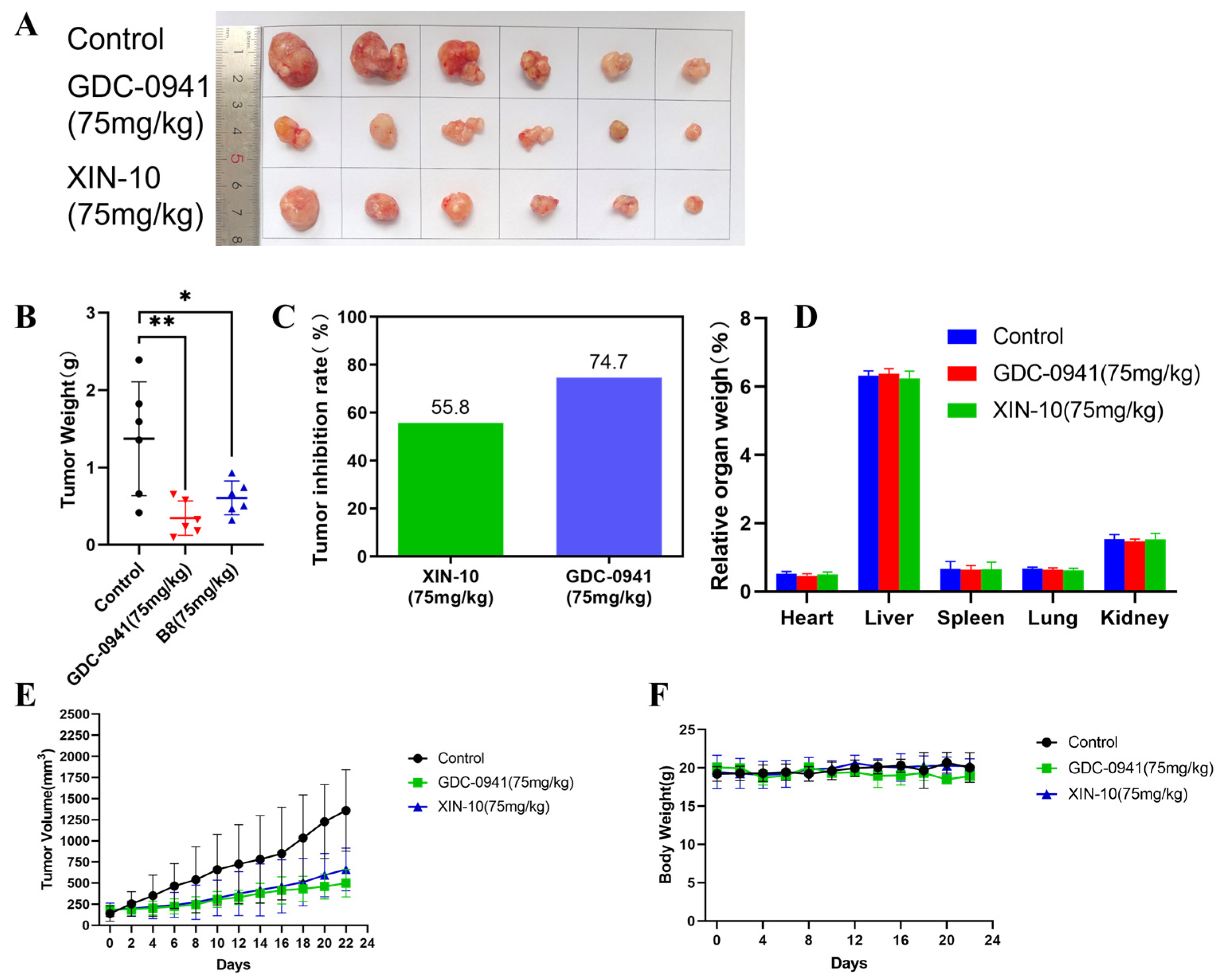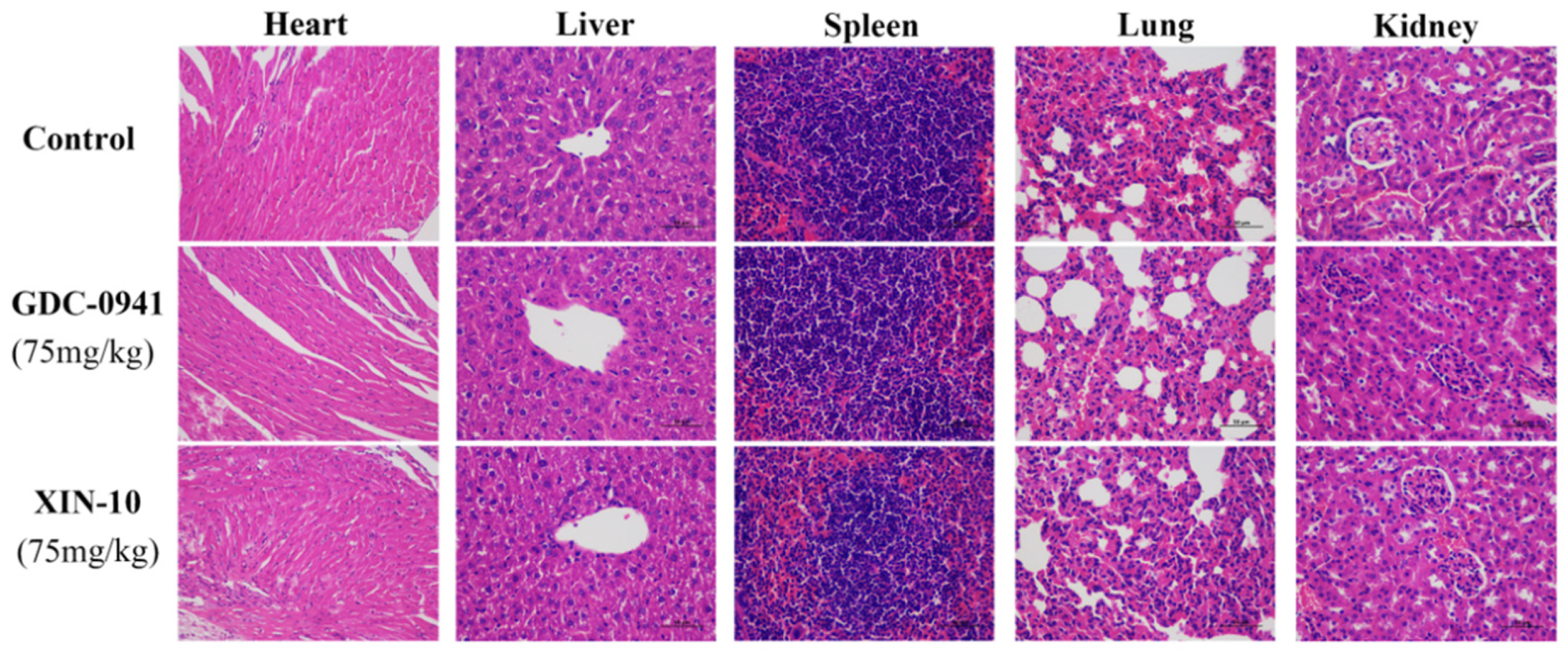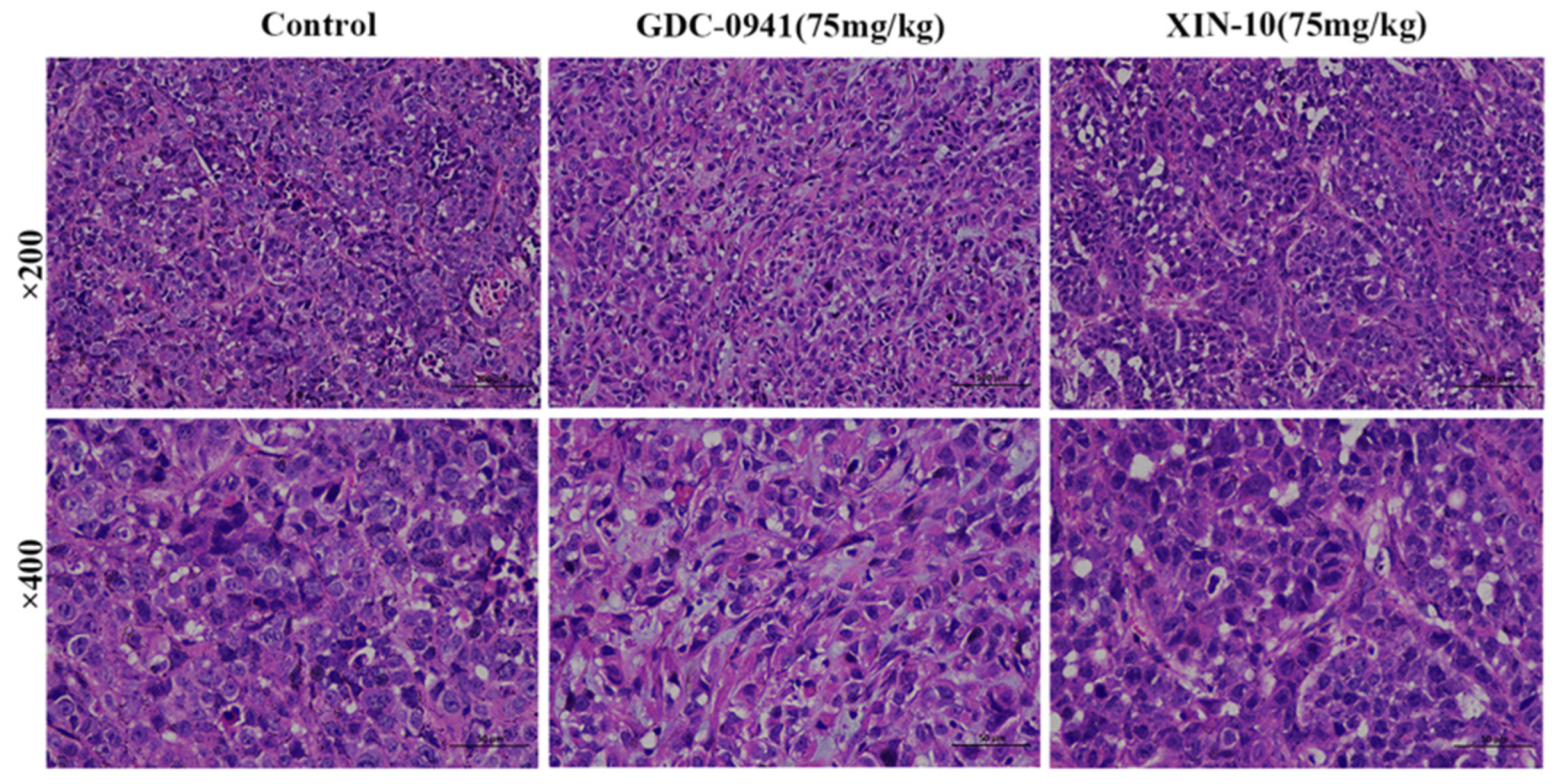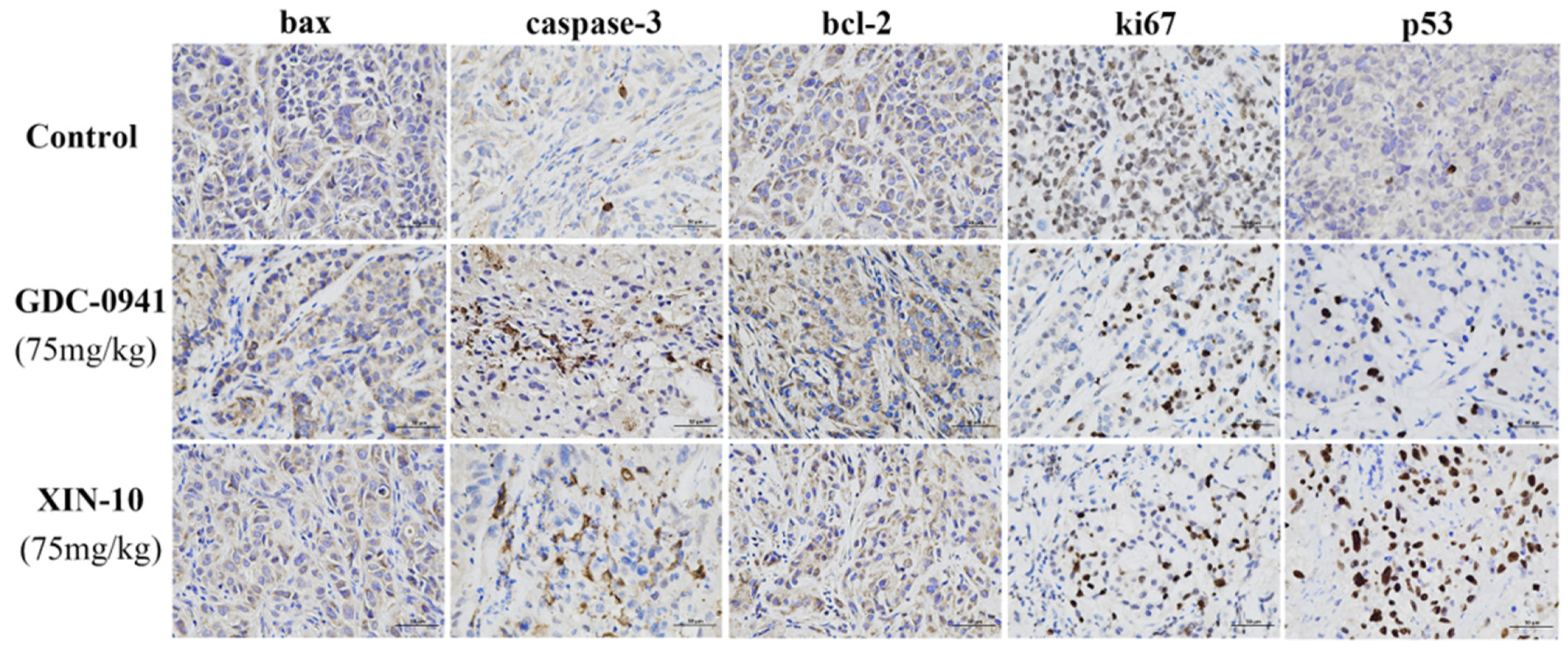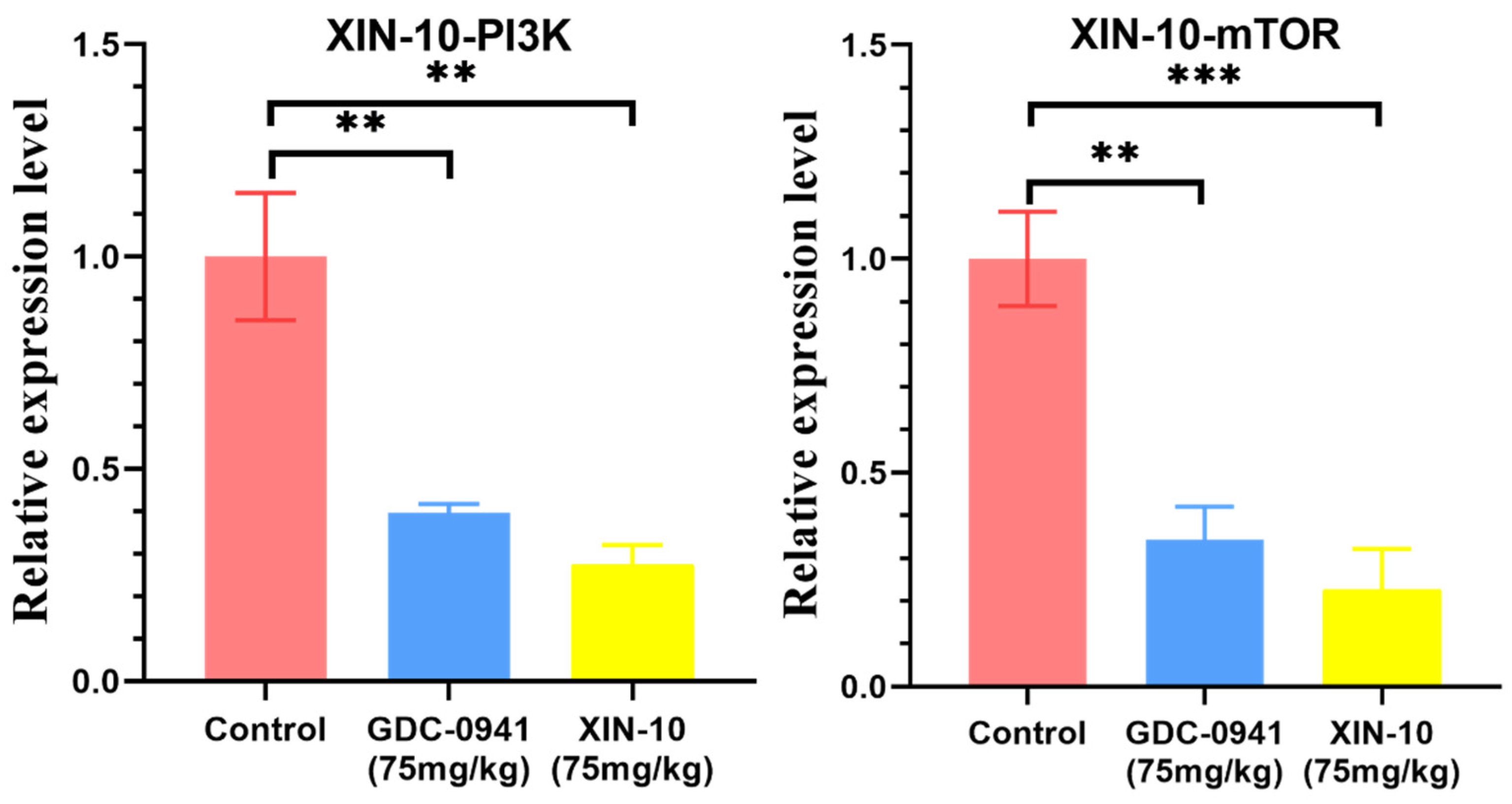1. Introduction
Cancer begins with cell mutation, where infinitely proliferating cancer cells invade and destroy normal tissues and organs, affecting human physiological functions and even being fatal [
1,
2,
3]. PI3K/AKT/mTOR is a major pathway in human cancer and is crucial in cell proliferation, metastasis, and metabolism, and blocking the related targets of this pathway can exert an inhibitory effect on cancer [
4,
5]. After the receptor on the cell membrane surface emits a signal, the p85 regulatory subunit of PI3K (phosphatidylinositol 3-kinase) is recruited to the cell plasma membrane, where it binds to the p110 catalytic subunit, which specifically catalyzes the conversion of PIP2 to PIP3 [
6,
7,
8,
9]. PIP3 binds to the PH structural domain of AKT (protein kinase B, PKB) [
10,
11]. AKT indirectly promotes the activation of mTOR (mammalian targets of rapamycin), which promotes cell growth and cell cycle progression [
12,
13]. Therefore, the development of drugs targeting key kinases of PI3K and mTOR has become a trend [
14,
15,
16].
GDC-0941 [
17,
18,
19] (Pictilisib), developed by Genentech, exhibits moderate selectivity with an IC50 of 3nM for both PI3Kα/δ. GDC-0941 induces autophagy and apoptosis in the majority of cancer cells. In in vivo experiments, its bioavailability can reach 78% after oral administration, with a high plasma protein binding rate. Unfortunately, GDC-0941 failed to achieve the primary goal of phase II clinical studies in breast cancer and led to serious adverse effects. Therefore, the subsequent development of GDC-0941 was terminated [
20].
In the present study, we conducted a series of studies using XIN-10, which was derived from the modification of GDC-0941. We investigated its kinase inhibitory activity, cytotoxicity, and antitumor ability in nude mice. Additionally, in order to study the anti-tumor mechanism of XIN-10, we conducted a series of experiments including cell cycle analysis, apoptosis assays, PCR, and Western blotting.
3. Discussion
In summary, this study reports that the dual PI3K/mTOR inhibitor XIN-10 can effectively inhibit the growth of MCF-7 cells in in vitro and in vivo settings. We conducted in vitro and in vivo antitumor activity studies on the dual PI3K/MOTR inhibitor XIN-10. The toxicity of XIN-10 on nine cell lines, including MCF-7 and Hela, was studied by the MTT method. In-depth pharmacological experiments were performed on compound XIN-10 to explore its mechanism of action. AO staining and FITC/PI double staining apoptosis assays showed that XIN-10 could induce apoptosis in MCF-7 and other cells. The cycle assay showed that it could block the proliferation of MCF-7 cells in S phase and also block the proliferation of A549 and Hela cells in G0/G1 phase. Reactive oxygen assay and mitochondrial membrane potential assay showed that it could increase ROS level, decrease mitochondrial membrane potential, and induce apoptosis in MCF-7 cells. Colony and migration assays showed that XIN-10 could effectively inhibit the proliferation and migration of MCF-7 cells. Fluorescence quantitative PCR experiments showed that it could significantly inhibit the expression of PI3K and mTOR genes in MCF-7 cells. In addition, Western blotting results showed that it inhibited phosphorylation of AKT-S473 in a dose-dependent manner and blocked phosphorylation of the down-stream pathway mTOR. The antitumor activity of compound XIN-10 was investigated in nude mice using the MCF-7 cell transplantation tumor model. The mean tumor weight of the XIN-10 treated group (75 mg/kg) was significantly different from that of the blank group, and the tumor inhibition rate was 55.8%. No pathological reaction was found in the organs of nude mice by HE staining. TUNEL staining and immunohistochemical assay of transplanted tumors showed that XIN-10 induced apoptosis in MCF-7 cell transplanted tumors. PCR results showed that it significantly inhibited the expression of PI3K and mTOR in MCF-7 transplanted tumors. Taken together, compound XIN-10 is a promising therapeutic approach as a dual PI3K/mTOR inhibitor for the treatment of breast cancer.
The mTOR single inhibitors often trigger negative feedback regulation of AKT when inhibiting mTOR, thereby reactivating the PI3K pathway. Although PI3K selective inhibitors can avoid negative feedback regulation of AKT, they may be affected by the catalytic subunit p110 α mutations leading to drug resistance. In addition, PI3K monotherapy affects insulin metabolism, leading to side effects such as hyperglycemia, anorexia, and nausea. Furthermore, PI3K/mTOR (especially PI3K) α/mTOR) dual ATP competitive inhibitors can directly act on key target proteins PI3K and mTOR, thereby more efficiently inhibiting the PI3K/Akt/mTOR signaling pathway, effectively preventing other factors from activating the PI3K pathway, and reducing the resistance and side effects produced by single inhibitors [
21,
22,
23]. There are currently relevant reports on PI3K/mTOR dual inhibitors including Gedatolisib, Omipalisib, Apitolisib, etc. [
24,
25,
26], all of which are in Phase I or Phase II clinical stages. There are currently no small molecule inhibitors of PI3K/mTOR on the market. As a modified drug of the PI3K single inhibitor GDC-0941, XIN-10 has stronger MTT and qPCR effects than GDC-041, and its response to the mTOR target is also significantly higher than the latter. It has the same inhibitory effect as PI3K in terms of kinase inhibition activity; therefore, XIN-10 has strong potential as a dual inhibitor of PI3K/mTOR, and the development of dual inhibitors of PI3K/mTOR can serve as a reference for cancer and research.
4. Methods and Materials
4.1. Reagents and Installations
The synthesis of XIN-10 is described in the
Supplemental Material Figure S1. The samples were confirmed for their purity and identification through the use of high-performance liquid chromatography, mass spectrometry, as well as nuclear magnetic resonance 1H and 13C spectroscopy. High performance liquid chromatograph purchased from Agilent (Beijing, China). The tandem quadrupole (triple quadrupole) mass spectrometer was purchased from Waters (Shanghai, China). Nuclear magnetic resonance NMR spectrometer purchased from Bruker (Beijing, China). The compound GDC-0941 was acquired from Sigma Chemical (St. Louis, MO, USA). We bought RPMI 1640 medium, DMEM high sugar medium, PBS buffer, and the penicillin–streptomycin combination from Solarbio (Beijing, China) for cancer cell culture reagents. Biological Industries (Israel) was the source of the fetal bovine serum that was acquired. Gibco (Waltham, MA, USA) provided the Trypsin-EDTA, and Keygen Biotechnology (Nanjin, China) supplied the AO Acridine Orange staining assay kit, PI/RnaseA cell cycle assay kit, and Annexin V-FITC/PI apoptosis assay kit. Yuhuan Southern Reagent Co. (Yuhuan, China) supplied 4% erythrocytes from sheep blood, while crystal violet, 10% TritonX-100, Hoechst 33,342, and ROS kits were obtained from Bayutai, China. The MMP assay kit, the fixative made from paraformaldehyde, the kit for isolating cell mitochondria using JC-1, and the 0.25% trypsin (EDTA-free) were bought from Servicebio (Wuhan, China). Takara (Shiga, Japan) was the source of the PCR experiments, which involved the acquisition of the PrimeScript RT reagent kit, total RNA extraction kit, DEPC water, agarose, sequence-specific primers, and TB Green Premix Ex Taq kits. Antibodies for the Western blot experiments that were associated were bought from Affinity (Changzhou, China). Servicebio (Wuhan, China) provided rIPA lysate, PMSF, 5 × SDS-PAGE protein loading buffer, and SDS-PAGE gel preparation kits. Beyotime (Shanghai, China) was the source of the purchased goat anti-rabbit IgG, bovine V albumin, skim milk powder, ECL A solution, and ECL B solution. The mice and nude mice used in the animal experiments were purchased from Silaikejingda (Changsha, China). IX71 fluorescence inverted microscope purchased from OLYMPUS (Tokyo, Japan). SPECTRA MAX plus Enzyme Labeler purchased from Thermo Scientific (Waltham, MA, USA). C6 flow cytometer purchased from BD (Shanghai, China). DYY-6C electrophoresis analyzer purchased from Liuyi Biotechnology (Beijing, China). PCR instruments and agarose gel electrophoresis tank were purchased from Bio-Rad (Hercules, CA, USA). Fully automated gel imager purchased from SYNGENE (Cambridge, UK).
4.2. Synthesis of 1-(1-methylpyrazolin-4-yl)-3-(4-(4-morpholin-6-(5-(morpholinomethyl)thiophen-2-yl)-1,3,5-triazin-2-yl)phenyl)urea (XIN-10)
XIN-10 was produced through a series of chemical reactions involving morpholine substitution, Suzuki coupling, acylation, reductive amination with morpholine, and aminourea generation, starting from 2,4,6-trichloro-1,3,5-triazine.
A solid of a pale-yellow color was obtained with a yield of 67.2%. M.P.: 156.4–157.7 °C. In the 1H NMR spectrum (at 400 MHz, using DMSO-d6 as the solvent), the chemical shifts are as follows: 9.04 (singlet, 1H), 8.48 (singlet, 1H), 8.39 (doublet, J = 8.3 Hz, 2H), 8.01 (doublet, J = 3.5 Hz, 1H), 7.80 (singlet, 1H), 7.62 (doublet, J = 8.4 Hz, 2H), 7.41 (singlet, 1H), 7.11 (doublet, J = 3.4 Hz, 1H), 3.95 (doublet, J = 17.5 Hz, 4H), 3.81 (singlet, 3H), 3.75 (doublet, J = 6.6 Hz, 6H), 3.66–3.59 (multiplet, 4H), and 2.47 (doublet, J = 5.5 Hz, 4H). The 13C NMR spectrum (101 MHz, DMSO-d6) shows peaks at chemical shifts of 168.98, 165.88, 163.41, 151.35, 147.56, 143.22, 140.38, 129.78, 129.20, 128.76 (2, C), 127.99, 126.89, 120.90, 120.40, 116.59 (2, C), 65.58 (2, C), 65.36 (2, C), 56.47, 52.36 (2, C), 42.72 (2, C), and 38.06.
The calculated mass-to-charge ratio (m/z) for the TOF MS ES + (M + H) + of C22H27N5O2S is 562.2349, which was also found to be 562.2349. HPLC (CH3CN/H2O (KH2PO4 = 20 mM)): tR: 5.643 min, purity: 97.73%. Additional information, including specific characterization data and spectra, can be located in the
Supplementary Material Figures S2–S5.
4.3. In Vitro Assays to Measure the Inhibitory Activity against Cell Proliferation
The anti-proliferative activity of XIN-10 on various cancer cell lines including MCF-7, ovcar, A549, NCI-H460, H1975, H2228, U87MG, Hela, Hela-mdr, and human normal hepatocellular carcinoma cells LO-2 was evaluated using the MTT assay. GDC-0941 was used as a positive control. Our previous research formed the basis for the specific procedure [
27].
4.4. Assays for Inhibiting Enzymes
Sandia Medical Technology (Shanghai, China) Co. conducted inhibitory activity assays for PI3Kα, mTOR, Met, AKT1, and EGFR kinases. In short, various compounds and enzymes were diluted in kinase buffer to the specified concentrations.
4.5. AO Staining Method
Cells that were multiplying exponentially were transformed into a suspension of cells and then introduced into 24-well plates with a density of 2.0 × 104. The cells were introduced into 24-well plates with a concentration ranging from 2.0 × 104 to 4.0 × 104 cells per well. Following the specified duration of drug activity, the cells were incubated in the incubator for 15 min using acridine orange (AO) added to the culture solution, and cell morphology and cell fluorescence were observed under an inverted microscope. Acridine Orange is able to penetrate conventional cell membranes and can be used to stain DNA and RNA in the nucleus. Under the microscope, AO develops an intact, uniform green or yellow-green fluorescence. Apoptotic cells exhibit chromatin condensation or fragmentation, resulting in the formation of apoptotic vesicles with mixed-sized fragments. These vesicles are subsequently stained by AO with intense yellow-green fluorescence. In contrast, necrotic cells show reduced or complete loss of fluorescence after AO staining.
4.6. Cell Cycle Assay
The Cell Cycle Analysis Kit (Beyotime Biotechnology Shanghai, China) was used to identify the phase of the cell cycle. The three cell lines were treated with varying amounts of XIN-10 (0.3 and 0.6 μM) in this study, and subsequently examined using flow cytometry after 24 and 48 h of treatment. To summarize, cells in the logarithmic growth phase were introduced into 6-well plates at a density of 1 × 106 cells per well. After 24 h, a specific amount of XIN-10 was introduced into the medium containing the cells. After 48 h of incubation, the cells that were in opposition were made into a suspension and then washed two times using a phosphate buffered solution (PBS). Cells were collected, fixed in 70% ice ethanol, and then incubated at 4 °C for 2 h or overnight. The cells were placed in an incubator and then rinsed two times with PBS. In a dimly lit setting, the prearranged dye (RNase A propidium iodide = 91) was introduced to the cells. In dark conditions, the response time exceeded 30–60 min. A flow cytometer (BD Accuri™C6, Piscataway, NJ, USA) was utilized to gather cells (1 × 104). Analysis of the last phase of the cell cycle was conducted.
4.7. Cell Apoptosis
The Annexin V-FITC/PI Apoptosis Assay Kit (Beyotime Biotechnology) was utilized to conduct the apoptosis assay. Following the cyclic experimental procedure mentioned earlier, cells were seeded in 6-well plates and exposed to compound XIN-10 for a duration of 48 h. Subsequently, the cells were digested, centrifuged, rinsed twice with PBS, and the supernatants were discarded. Further operations were conducted in a dim setting. The cells were treated with Annexin V-FITC and PI staining solutions in a dark setting for 15 min, and flow cytometry (BD Accuri™C6) was primarily used to detect apoptosis.
4.8. Cell Colony Formation Assay
A total of 5000 cells were cultured in 6-well plates, where the cells were in logarithmic growth phase. Twenty-four hours later XIN-10 was added and incubated. After 48 h, the cells were substituted every 2 days and the condition of the cells was monitored for a period of 14 days, or until the majority of individual clones contained over 50 cells. Afterwards, the cells were rinsed twice with PBS and captured using a microscope to be counted. To fix the cells, 2 mL of 4% paraformaldehyde was added per well for 15–30 min, followed by aspiration of the paraformaldehyde. After aspirating paraformaldehyde, it was washed twice with PBS. Then, 1 mL of crystalline violet staining solution was added to each well, followed by a 15 min staining period and subsequent photography. After a duration of 15 min, photographs were taken of the complete six-well plate as well as each individual well. Images captured every individual well. Calculation was performed to determine the rate of cell clone formation among various groups. Mathematical analysis was used to determine the effect of the drug on the growth of cancer cells.
4.9. Real-Time PCR
The relative expression of PIK3CA (P110) and mTOR1 mRNA was detected using real-time PCR. TRIzol reagent (Life Technologies Shanghai, China) was used to extract total RNA from drug-spiked cells following the provided instructions. The cDNA was acquired through reverse transcription utilizing the PrimeScript RT kit and gDNA Eraser from Takara. To measure the amounts of transcripts, a PrimeScript RT Master Mix from Takara and a real-time PCR system called Stratagene Mx3000p were utilized for SYBR Green qPCR. In humans, the forward primer for PI3K is GGGCTTTCTGTCTCCTCTAAAC, while the reverse primer is ATGTCTGGGTTCTCCCAATTC. The human mTOR forward primer sequence is GCTGTGAGGTCTGAGTTTAAGG, while the reverse primer sequence is ATTGCCTTCTGCCTCTTATGG. To control the internal mRNA level, GAPDH was utilized. Fold change relative to the internal control is used to express the results.
4.10. Cell Scratch Assay
To investigate the impact of compound XIN-10 on the migratory and reparative capabilities of MCF-7 cells, the scratch assay was employed. The ability of MCF-7 cells to migrate and repair is being studied. On the backside of a 6-well plate, create parallel and uniform scratches, and each well was inoculated with around 5 × 105 cells. After the cells were fully developed, the vertical tip of the gun was slid along the indicated path and the markings were traced with a fingernail. Rinse thoroughly twice with PBS to remove damaged cells. After incubating the cells, the medium was changed and the cells were observed under a microscope and images were taken. The cells were then observed under a microscope and photographed, and then the culture was continued in the incubator.The process of incubation was prolonged inside the incubator. After a period of 24 h, the cells were extracted, examined using a microscope, and captured in photographs.
4.11. JC-1 Assay
JC-1 was employed to assess the impact of compound XIN-10 on MMP in MCF-7 cell lines. Maintaining a normal physiological function of mitochondria and cells requires a standard mitochondrial membrane potential (MMP). A prerequisite for normal physiological function of mitochondria and cells. Hence, a reduction in MMP serves as a significant indicator of apoptosis. The cell suspensions were placed in 24-well plates with a cell density ranging from 2.0 × 104 to 4.0 × 104 cells per well. They were then incubated in an incubator for a duration of 24 h. After 24 h of incubation in the incubator, XIN-10 was added to the culture. After a period of 24 to 36 h, the cells were treated with the JC-1 kit and examined using a microscope. The JC-1 kit was examined using a fluorescent microscope (OLYMPUS, Tokyo, Japan).
4.12. ROS
The cells were taken in log proliferation phase, the cell suspension was inoculated at a density of 2.0 × 105 cells/3 mL/well in a 6-well plate and incubated in the incubator for 24 h. The culture solution containing the compounds was added, and the solution was incubated in the incubator for the indicated time. The old culture medium was discarded, cells were washed with PBS 2 times and then stained with Hoechst 33,342 for 10 min. After washing the cells with PBS 2 times, 1 mL of culture medium mixed with DCFH-DA was added to each well. The paraformaldehyde was aspirated off, the cells were washed with PBS 2 times, and then cells were stained with crystal violet staining for 1 mL/well, and left to stand for 15 min. After washing the cells with PBS 2 times, the cells were observed under the fluorescence microscope, and pictures were taken.
4.13. Western Blot Method
The expression of PI3K, AKT, mTOR, S6K1, and other related proteins was detected using Western blotting. Proteins such as mTOR and S6K1, along with other proteins that are associated with them, were obtained from tumor tissue cells, which were broken down in a lysis solution for 30 min. After that, the mixture was centrifuged at 4 °C and 12,000 r/min for 5 min. Following centrifugation, the liquid portion above the sediment was collected. Following the determination of protein concentration using the BCA technique, the samples underwent gel electrophoresis followed by transferring the membrane. A closure containing 5% skim milk powder was used. The primary antibody was applied at a dilution of 1:1 and incubated overnight. The primary antibody was also applied at a dilution of 1:1000. After that, the secondary antibody was applied at a dilution of 1:10,000 and incubated for 2 h at room temperature. The gel was then developed using a chemiluminescence-based gel imaging system. The bands were quantified using Quantity One v4.6.6 and CellSens (version 1.6.0) Version 4.6.6, Image J 180, and various other software options are available for quantification.
4.14. Molecular Modeling
The protein ligands PI3K (PI3K PDB: 4L23 and mTOR PDB: 4JT6) were downloaded from the RCSB database (
http//www.wwpdb.org/, accessed on 24 August 2022). The PDB was processed with Autodock 4.2 software. Preparation of the molecule: the small molecule structure was drawn with the software ChemDraw 3D (Version 16.0.0.82). It was saved in PDB format, and the structure was optimised with the software Autodock 4.2 to obtain a lower energy molecular conformation. Docking: the ligand and the molecule were positioned, energy optimised and docked. The docking results with good conformation were screened and saved. Modification by Pymol software(Version 2.0).
4.15. Assessment of Hemolytic Toxicity
Testing the safety of an injection involves observing the occurrence of a hemolytic reaction. To remove the fluid used to preserve the red blood cells, a centrifuge tube containing 1.5 mL of sheep blood erythrocytes with a concentration of 2% was spun at 3000 rpm for 5 min. Next, a 0.9% saline solution is added to the centrifuge tube to disperse the red blood cells. To serve as a negative control, physiological saline was utilized, while 1% TritonX-100 was employed as a positive control. The corresponding concentration of compound XIN-10 was added to 2% sheep blood erythrocyte saline. The mixture mentioned above was placed in an incubator for one hour at a temperature of 37 degrees Celsius. During this time, it was monitored for any signs of hemolysis or agglutination reactions. Under chilled conditions, the supernatant was spun at 3000 rpm for 5 min, and 500 μL of the resulting liquid was collected. Subsequently, the absorbance at 540 nm was determined using a UV spectrophotometer. In the end, the rate of hemolysis was determined using the provided formula. The percentage of hemolysis rate is calculated by subtracting the negative control group from the experimental group and dividing it by the difference between the positive control group and the negative control group.
4.16. Mouse Toxicity Experiments
Three mice from Kunming were divided into three groups: the blank group (treated with 0.9% saline), the positive group (treated with GDC-0941), and the XIN-10 group. The dose administered to each group was 75 mg/kg. Following 8 days of gavage treatment (administered 4 times every second day), blood samples were obtained from the mice’s ocular region. Serum was obtained by centrifugation after collecting blood from the eyes of mice. A preoperative, 10-item, quantitative assay kit and a biochemical analyzer were utilized to evaluate the serum, liver, and kidney functions. Histological analysis of mice involved dissection of the animals followed by staining their organs with hematoxylin–eosin acid (H&E staining).
4.17. Tumor Xenograft Experiments
All animal research conducted adhered to the ARRIVE guidelines and received approval from the animal ethics committee. Cell inoculation was used to construct nude mice tumor models using 18 BALB/c nude mice (female, 4–6 weeks) obtained from Hunan Slaughter and Jingda Laboratory Animal Co., all of which were thymus-free. Cells from inoculated nude mice were selected at logarithmic growth stages. Following the process of digestion, centrifugation, and cell counting, the cells that were centrifuged were ultimately suspended in saline solution. Subcutaneously injecting 0.2 mL of the cell suspension (5 × 106 cells) into the right ventral region of the axilla was performed in the mice. The medication was administered orally for treatment. The length and width of the tumor were measured every two days and the volume was calculated using the ellipsoidal volume formula. Upon reaching a tumor volume of 150–180 mm3, the mice were administered compounds XIN-10 (75 mg/kg) and GDC-0941 (75 mg/kg) orally for treatment. Medication was given by mouth every second day for a period of 3 weeks. Afterwards, the mice underwent dissection. Wuhan Xavier conducted H&E staining and immunohistochemistry experiments on their tumor tissues and organ sections.
4.18. Statistical Analysis
The IC50 values of the compounds were determined by first analyzing the MTT absorbance data to obtain the inhibition rate and then establishing a probit model by normalizing the data with IBM SPSS Statistics 22. Experiments such as cell migration and AO staining were carried out by using imageJ(Version java6 20170530ver) for the recording of the area and the number of cells. The data were plotted by using Graphpad Prism 8.0.2 software and significant difference analysis was conducted to obtain the p-value by its t-test analysis. The Western blots were quantified using Quantity One v4.6.6.
